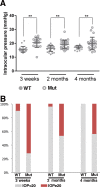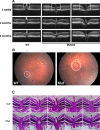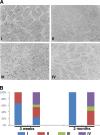Heterozygous Pitx2 Null Mice Accurately Recapitulate the Ocular Features of Axenfeld-Rieger Syndrome and Congenital Glaucoma
- PMID: 27654429
- PMCID: PMC5040192
- DOI: 10.1167/iovs.16-19700
Heterozygous Pitx2 Null Mice Accurately Recapitulate the Ocular Features of Axenfeld-Rieger Syndrome and Congenital Glaucoma
Abstract
Purpose: The purpose of this analysis was to assess the utility of Pitx2+/- mice as a model for the ocular features of Axenfeld-Rieger Syndrome and for congenital glaucoma.
Methods: Eyes of Pitx2+/- and wild-type littermates were examined clinically using optical coherence tomography (OCT) and fundus photography. Intraocular pressures were measured using a TonoLab rebound tonometer. Eyes were examined histologically to assess PITX2 expression, structural integrity, and optic nerve and ganglion cell content.
Results: PITX2 is present postnatally in the corneal endothelium and stroma, iris stroma, trabecular meshwork, and Schlemm's canal. Reduced central corneal thickness, iris defects, and iridicorneal adhesions are all prevalent in Pitx2+/- eyes. Although optic nerve heads appear normal at postnatal day 7, IOP is elevated and optic nerve head cupping is fully penetrant in Pitx2+/- eyes by 3 weeks of age. Neurodegeneration is present in a significant percentage of optic nerves from Pitx2+/- mice by 3 weeks of age, and is fully penetrant by 2 months of age. Pitx2+/- eyes show significant reductions in specifically ganglion cell density in all four quadrants by 2 months of age.
Conclusions: Pitx2+/- mice model the major ocular features of Axenfeld-Rieger Syndrome and will be an important resource for understanding the molecular mechanisms leading to anterior segment dysgenesis and a high prevalence of glaucoma in this disease. In addition, these mice may provide an efficient new model for assessing the molecular events in glaucoma more generally, and for developing and testing new treatment paradigms for this disease.
Figures






References
-
- Tham YC,, Li X,, Wong TY,, Quigley HA,, Aung T,, Cheng CY. Global prevalence of glaucoma and projections of glaucoma burden through 2040: a systematic review and meta-analysis. Ophthalmology. 2014; 121: 2081–2090. - PubMed
-
- King A,, Azuara-Blanco A,, Tuulonen A. Glaucoma. BMJ. 2013; 346: f3518. - PubMed
-
- Mantravadi AV,, Vadhar N. Glaucoma. Prim Care. 2015; 42 (3): 437–449. - PubMed
-
- Heijl A,, Leske MC,, Bengtsson B,, Hyman L,, Hussein M. Reduction of intraocular pressure and glaucoma progression: results from the Early Manifest Glaucoma Trial. Arch Ophthalmol. 2002; 120: 1268–1279. - PubMed
-
- Quigley HA. Open-angle glaucoma. N Engl J Med. 1993; 328: 1097–1106. - PubMed
Grants and funding
LinkOut - more resources
Full Text Sources
Other Literature Sources
Molecular Biology Databases

